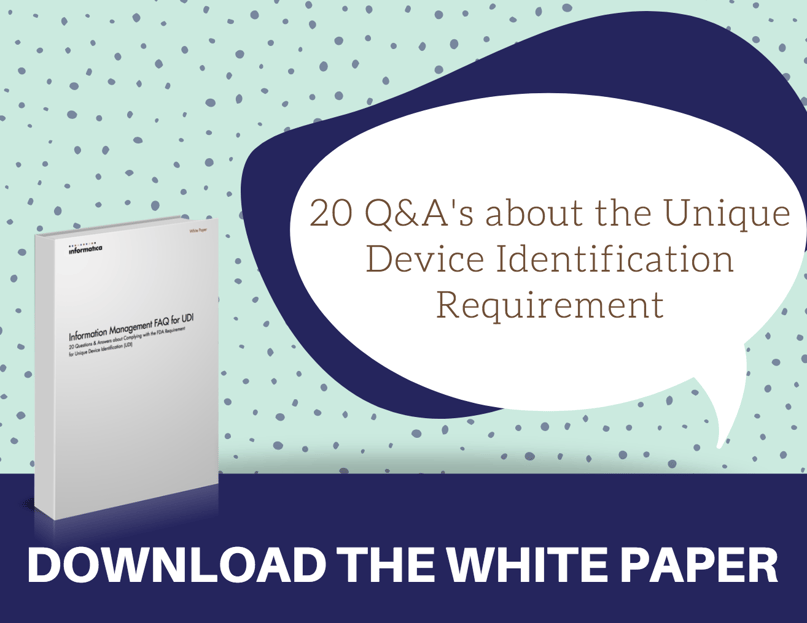
A Quick Summary of UDI
The Unique Device Identification System, commonly referred to as UDI, is an Food and Drug Administration (FDA) rule that requires medical device labelers to mark medical packages and devices with a unique barcode. These labels aid supply chain and healthcare professionals in accurately identifying medical devices during transit and use. Any medical device on the US market falls under the FDAs UDI requirements.
Get a more in-depth look at the who, what, where, and why of UDI
Labelers and Medical Devices
Device labelers must include a unique device identifier on all non-exempt medical devices and packages that are sold in the United States. Depending on the type of device, these UDI barcodes must be placed on the body of the medical device and/or on the device packaging. Medical devices are defined as "an instrument, apparatus, implement, machine, contrivance, implant, in vitro reagent, or other similar or related article, including a component part, or accessory...intended for use in the diagnosis of disease or other conditions, or in the cure, mitigation, treatment, or prevention of disease...which does not achieve any of its primary intended purposes through chemical action. Labelers are any person who causes a label to be applied to a device, or who causes the label of a device to be modified, with the intent that the device will be commercially distributed without any subsequent replacement or modification of the label." In essence, the last person to touch the device's label before it is distributed is the person in the supply chain who is required to comply with UDI guidelines. Labelers are most often the device manufacturers, but that is not always the case. The labeler could also be a repackage, preprocessor, relabeled, kit assembler, or specification developer. Whether or not a company is responsible for a UDI label depends on what type of medical device they process and where in the supply chain they handle it.
Curious what the benefits of UDI will be?
The Unique Device Identifier
Unique device identifiers are assigned to each model and version of a medical device. Labels must be readable by humans and automatic identification and data capture (AICD) technology. The FDA defines AIDC as "any technology that conveys the UDI or the device identifier of a device in a form that can be entered into an electronic patient record or other computer system via an automated process."  UDI numbers must come from an FDA-accredited issuing agency. At this point in time, there are three appointed agencies: GS1, Health Industry Business Communications Council (HIBCC), and ICCBBA. The UDI barcode can be broken down into two parts: the device identifier (DI) and production identifier (PI). DIs indicate the device model and the company that is the "labeler." This piece of the barcode is mandatory and, once assigned, never changes. Each DI can only be associated with one device model and one labeler. Any change in this information requires a new DI. PIs are more fluid and may not be included in all UDI barcodes. A PI will be different for each batch or for each serialized device. Depending on the type of medical device, PIs might include a right:
UDI numbers must come from an FDA-accredited issuing agency. At this point in time, there are three appointed agencies: GS1, Health Industry Business Communications Council (HIBCC), and ICCBBA. The UDI barcode can be broken down into two parts: the device identifier (DI) and production identifier (PI). DIs indicate the device model and the company that is the "labeler." This piece of the barcode is mandatory and, once assigned, never changes. Each DI can only be associated with one device model and one labeler. Any change in this information requires a new DI. PIs are more fluid and may not be included in all UDI barcodes. A PI will be different for each batch or for each serialized device. Depending on the type of medical device, PIs might include a right:
- Serial Number
- Batch Number
- Expiration Date
- Manufacture Date
- And/or a specific code that is required for certain human tissue or cellular-based products that are regulated as devices
To minimize the burden placed on labelers, the FDA has included a handful of alternatives and exemptions for certain medical devices.
Levels of Labeling
UDI labels will vary in level based on the medical device and its packaging. To help clarify each level of labeling, take a look at the following example provided by the FDA.
- DI 1001 - The base package, the lowest level of a device package with a full UDI, is a single-wrapped catheter. The UDI is on the individual device wrapper and the base package DI is 1001.
- DI 2001 - The individually wrapped catheters are packaged in a box of thirty. That box of thirty is related to the base package, but is a separate package level. It requires a different DI that is related to the UDI of the single-wrapped catheter.
- DI 2002 - If the catheters are also packaged in boxes of fifty, that would require a second DI that is different from the DI on the box of thirty, but still related to the base package.
- DI 3001 - Multiple boxes can also be packaged together in a case, which would form a third package level. If boxes of thirty catheters are packaged twelve to a case, that case requires a new DI that is again related to the base.
Shipping containers are exempt from this rule. For instance, when multiple medical devices are ordered and shipped together, the logistics container does not fall under UDI rules. Pallets, bubble wrap, and inner linings also do not require a UDI. A kit would be considered the base package; a UDI would be needed for the kit but not for the individual pieces inside the kit. However, if a device inside the kit was sold separately it would need a UDI label. In addition, medical devices that are intended to be used more than once and be reprocessed between uses must have the UDI label directly on the device. This label can be human and/or AIDC-readable.
In addition, medical devices that are intended to be used more than once and be reprocessed between uses must have the UDI label directly on the device. This label can be human and/or AIDC-readable.
Learn why the FDI will be strict in enforcing UDI
GUDID
The ultimate objective of many UDI advocates is to implement a global program that would monitor, recall, and analyze medical devices on every continent. By creating a universal language, the benefits of UDI would spread globally. Explore our article, "What are the Benefits of Unique Device Identification" to discover all the benefits of UDI. In effort to create a global system of medical device identification, the FDA administered the Global Unique Device Identification Database (GUDID). The GUDID collects and maintains information regarding medical devices and manufacturers directly from the device labelers. Through a partnership between the FDA and the National Library of Medicine, information collected by GUDID is then made public and accessible to hospitals, healthcare professional, and patients through a web portal called AccessGUDID. Access GUDID is updated every day with the most recent information that has been submitted to the FDA. The FDA has a user manual outlining how to sign up for and use AccessGUDID if your organization will be submitting UDI information. If you simply want to view device information, creating an account is not necessary. Information can be searched on the GUDID using a medical device's DI. PIs are not included in the GUDID.
Formatting Dates
The original UDI proposal specified that all labels include a date in the format of month day, year (i.e. March 15, 2017). However, the FDA received feedback from concerned parties. It was noted that the proposed format would force companies to label devices marketed in the United States differently from those marketed internationally. The FDA took these comments and revised its date requirements. In the final rule, it is specified that all dates on medical device labels must follow the format of YYYY-MM-DD (i.e. 2017-03-15). For expiration dates, if a medical device expires not on a particular day but expires in a particular month, the labeler should choose the last day of the month for the label. For instance, if a device expires in November of 2017, the expiration date should be listed as 2017-11-30. 

Posted by PDI Marketing Team
Pacific Data Integrators Offers Unique Data Solutions Leveraging AI/ML, Large Language Models (Open AI: GPT-4, Meta: Llama2, Databricks: Dolly), Cloud, Data Management and Analytics Technologies, Helping Leading Organizations Solve Their Critical Business Challenges, Drive Data Driven Insights, Improve Decision-Making, and Achieve Business Objectives.




